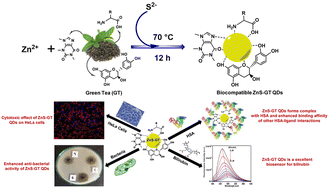Formation of ZnS quantum dots using green tea extract: applications to protein binding, bio-sensing, anti-bacterial and cell cytotoxicity studies†
Abstract
Biocompatible quantum dots (QDs) have attracted a lot of attention due to their potential biological applications (drug delivery, sensing and diagnosis). Here, we have synthesized 2–4 nm sized biocompatible zinc sulphide (ZnS) QDs using a plant leaf extract as an immobilizing and stabilizing agent via a green route. We have investigated the biological effects of ZnS QDs in a variety of applications, including (1) anti-bacterial activity, (2) cell cytotoxicity, (3) bio-sensing and (4) protein binding. Studies on the anti-bacterial activity of the as-synthesized ZnS QDs against E. coli and E. faecalis inhibited bacterial growth effectively and showed a cytotoxic effect on the HeLa cell line. The biosynthesized ZnS QDs act as a fluorescence probe to detect bilirubin and rifampicin (RFP) with a wide linear range, high sensitivity, good selectivity, and a low limit of detection (LOD), with LOD values of 22.12 ± 0.25 ng mL−1 and 122.37 ± 0.42 ng mL−1, respectively. In a biological matrix, the QDs can form a complex with biomacromolecules; therefore, we studied the interaction between a carrier protein (HSA) and the as-synthesized ZnS QDs. The surface functionalized and nano-sized ZnS-GT QDs were observed to form complexes with the human serum albumin (HSA) protein and quenched the intrinsic fluorescence of HSA through static and dynamic quenching modes. The binding affinity was observed to be of the order of 105 M−1 for the HSA–ZnS-GT QD interactions, which can be considered as a reversible mode of binding. The effect of the ZnS QDs on other ligands and protein interactions was also studied. Enhanced binding affinities for HSA–quercetin ((5.994 ± 0.139) × 105 M−1) and HSA–luteolin ((3.068 ± 0.127) × 105 M−1) interactions were also observed in the presence of ZnS-GT QDs.



 Please wait while we load your content...
Please wait while we load your content...